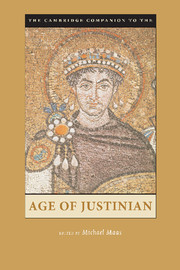Book contents
- Frontmatter
- Part 1 Structures and Ideologies of Empire
- Part 2 Religion and Philosophy
- Part 3 Literature and the Arts
- Part 4 Peoples and Communities
- 16 Jews in the Age of Justinian
- 17 The Age of Justinian
- 18 Justinian and the Barbarian Kingdoms
- 19 Byzantium and the East in the Sixth Century
- 20 The Background to Islam
- Bibliography
- Index
- Plate Section 1
- Plate Section 2
16 - Jews in the Age of Justinian
from Part 4 - Peoples and Communities
Published online by Cambridge University Press: 28 May 2006
- Frontmatter
- Part 1 Structures and Ideologies of Empire
- Part 2 Religion and Philosophy
- Part 3 Literature and the Arts
- Part 4 Peoples and Communities
- 16 Jews in the Age of Justinian
- 17 The Age of Justinian
- 18 Justinian and the Barbarian Kingdoms
- 19 Byzantium and the East in the Sixth Century
- 20 The Background to Islam
- Bibliography
- Index
- Plate Section 1
- Plate Section 2
Summary
“Withdrawing behind the rampart of talmudic law and religion, the Jewish people of the sixth century continued to pursue its historic career quietly, almost inarticulately.” This judgment of the foremost twentieth-century historian of the Jews writing in English, Salo Wittmayer Baron, encapsulates a commonly held view of the Jews in the Age of Justinian, yet it is a view that can be challenged in every particular. In what follows we shall endeavour to explore the foundations on which such a judgment rests, and hope to show that, insofar as one can speak of a “Jewish people” with a “historic career,” the latter was pursued anything but quietly or inarticulately. The sixth century was a time of dramatic change and strident conflict, a time of acute anxiety for Jews as for other minorities of the empire, but also a time of challenge and opportunity, a time that decisively shaped the character of Judaism in momentous ways.
The main obstacle facing anyone attempting to write the history of the Jews in the Age of Justinian is a shortage of securely datable written texts, especially texts written by Jews. Apart from a few characteristically laconic inscriptions, all the dated writings that we have were written by non-Jews, and almost all of these are inherently antagonistic to the Jews as a group. We are bound at every turn to recognise uncertainties and ambiguities in the evidence, to reconstruct the background to an obscure event, or to estimate the distance between ideology and reality. Accordingly we shall begin with an account of the available materials and an assessment of their reliability. But before doing so it is necessary to say a few words about the conventional periodisation of Jewish history during the Roman Empire, since this has an important bearing on how we assess developments in the sixth century.
- Type
- Chapter
- Information
- The Cambridge Companion to the Age of Justinian , pp. 401 - 426Publisher: Cambridge University PressPrint publication year: 2005
- 6
- Cited by

